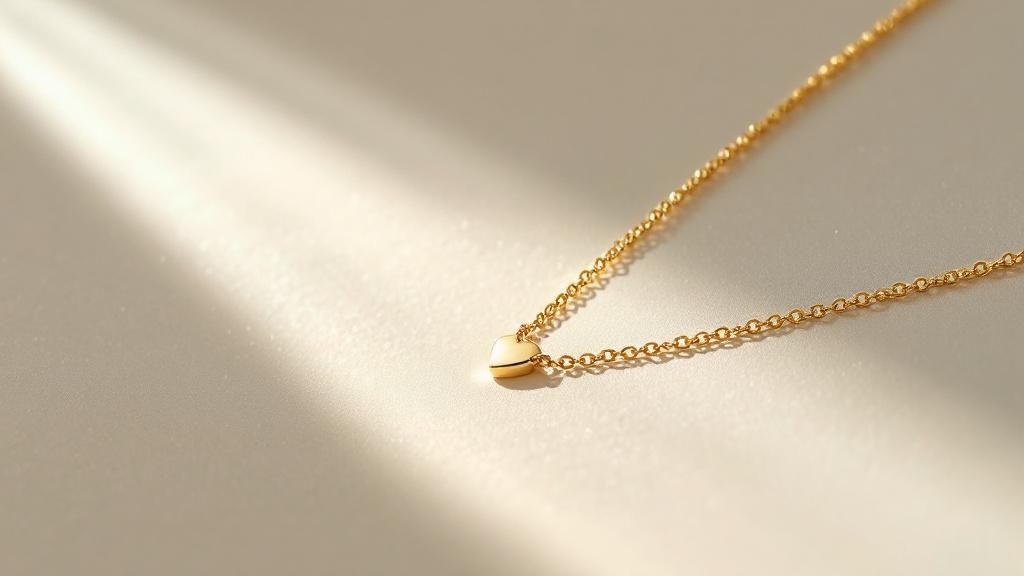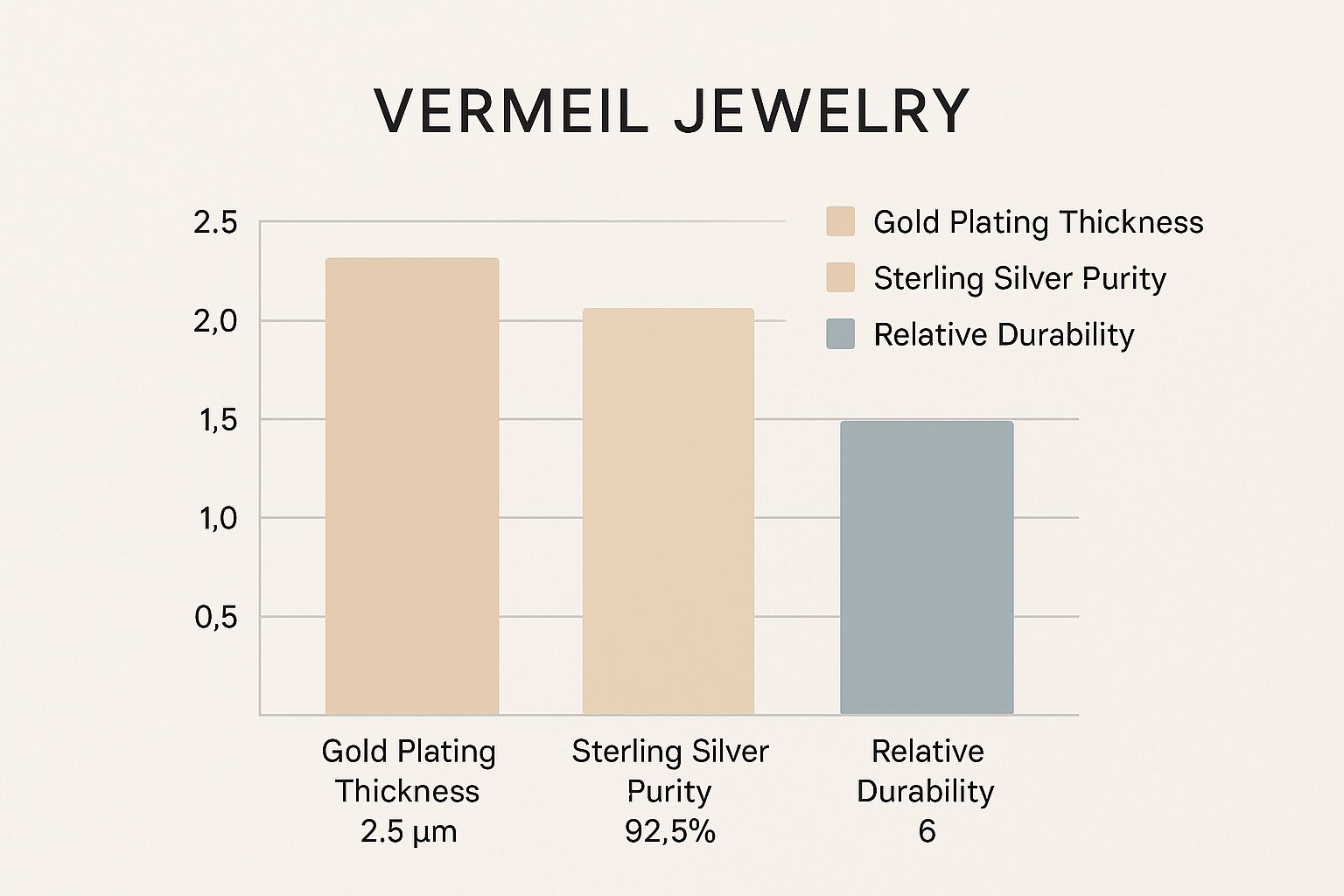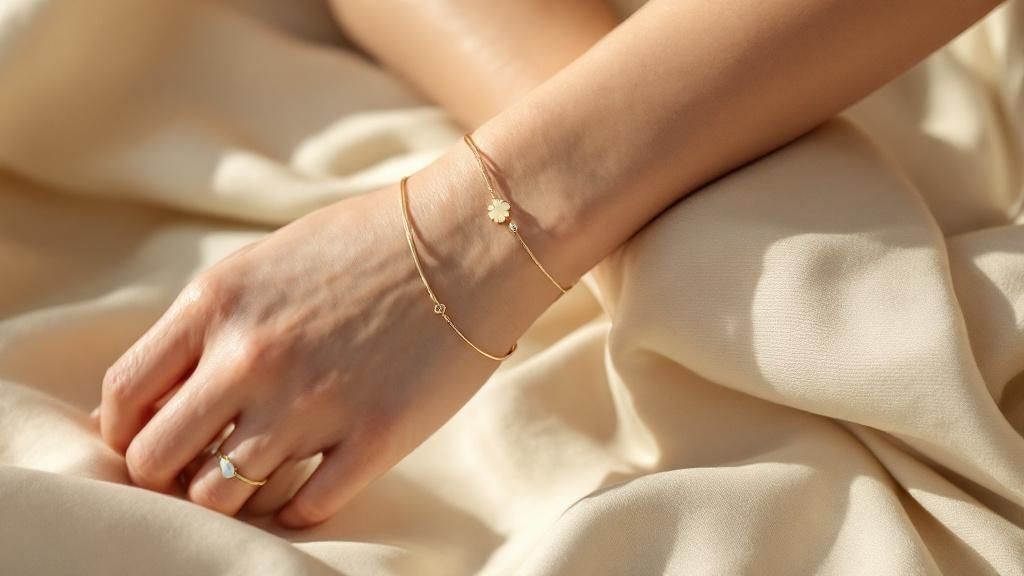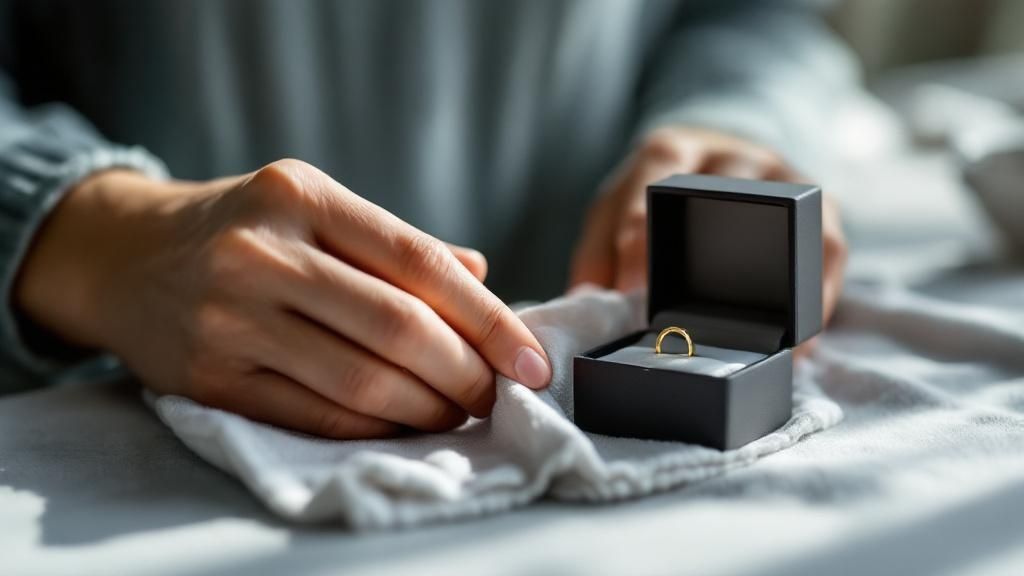Arthur Lynch | Sat Aug 23 2025
What Is Vermeil Jewelry? Your Guide to Affordable Luxury
So, you've probably heard the term "gold vermeil" popping up more and more, but what exactly is it? Think of it as the sweet spot in the jewelry world—a fantastic way to get the look and feel of solid gold without the hefty price tag. It’s a specific style of gold finishing that delivers on both quality and durability, making it a smart choice for building a stylish, long-lasting collection.
What is Gold Vermeil, Really?

Let's cut right to the chase. Vermeil isn't just a fancy name for gold plating; it’s a regulated term that guarantees a certain standard of quality. It strikes that perfect balance between the preciousness of fine jewelry and everyday accessibility, making it a key player in global fashion trends.
For a piece to officially be called "vermeil" in the United States, it has to meet two very specific, non-negotiable requirements:
- The Base Metal: At its heart, every vermeil piece must be made of sterling silver, which is 92.5% pure silver. Using a precious metal base gives the piece inherent value and makes it a safe, hypoallergenic choice for most people.
- The Gold Layer: The outer layer must be real gold of at least 10 karats, and crucially, it has to be a minimum of 2.5 microns thick.
That 2.5-micron thickness is the key actionable insight for shoppers. It's what makes vermeil far more durable and long-lasting than standard gold-plated jewelry, which often has a coating that's a fraction of that thickness. When buying, always confirm this specification to ensure you're getting true vermeil quality.
To make these standards crystal clear, here’s a quick breakdown of what makes vermeil, well, vermeil.
Vermeil Jewelry At a Glance
| Component | Standard Requirement | Why It Matters for Quality |
|---|---|---|
| Base Material | Must be sterling silver (92.5% pure silver) | Provides intrinsic value, durability, and is hypoallergenic for most people. |
| Gold Karat | At least 10 karat gold | Ensures the plating is made of real, quality gold, not a cheap imitation. |
| Gold Thickness | A minimum of 2.5 microns | This thick layer is crucial for long-lasting wear and preventing tarnish. |
This combination of a precious metal core and a heavy layer of real gold is what gives vermeil its premium status.
An Easy Way to Think About It
Imagine you're buying a high-quality leather jacket. Standard gold-plated jewelry (often with a brass or copper base) is like a flimsy, faux-leather jacket. It might look good from a distance, but it won't last.
Vermeil, on the other hand, is like a genuine, thick-cut leather jacket. You're starting with a premium material (sterling silver) and adding another high-quality layer on top (a thick coat of real gold). The result is a piece that feels substantial, looks luxurious, and is built to last.
This unique blend of quality and affordability is why vermeil is taking the jewelry world by storm. It allows designers everywhere—from those creating minimalist Scandinavian necklaces to artisans crafting bold, sculptural pieces in North America—to produce beautiful, on-trend jewelry that stands the test of time. It's the perfect answer for shoppers who want to move beyond fast-fashion accessories and invest in affordable luxury that lasts.
The Rich History and Enduring Appeal of Vermeil
Gold vermeil isn't just a modern trend; it's a technique steeped in a fascinating, centuries-old history. Long before it became a staple in demi-fine jewelry, ancient civilizations were already laying the groundwork for this craft, creating a legacy of artistry that gives vermeil its unique prestige.
The idea of layering gold over silver didn't just appear out of nowhere. It developed slowly over centuries across different cultures. As far back as the 4th century BC, ancient Romans were hammering thin gold leaf over silver objects. Separately, the Sican people in Peru were mastering similar gilding methods. By the 7th century, Anglo-Saxon goldsmiths were also using gold-gilding to make their limited gold supplies go further, creating stunning pieces with the appearance of solid gold.
These early, often dangerous, techniques like mercury gilding eventually gave way to the much safer and more precise electroplating process we use today. This modern method uses an electrical current to permanently bond a thick layer of gold to sterling silver, creating the durable and beautiful finish we know as vermeil. You can find out more about the fascinating evolution of this gold finish and its journey through history.
From French Royalty to Global Trend
The craft truly hit its stride and got its name—vermeil (pronounced vehr-may)—in 18th-century France. It quickly became the material of choice for French royalty and aristocrats who wanted the decadent look of solid gold for everything from cutlery and snuff boxes to, of course, their jewelry.
This strong historical tie to European nobility is a huge part of why vermeil still feels so luxurious. It was never seen as a "lesser" material but as a respected craft for creating high-quality, treasured heirlooms.
That legacy is alive and well today, with vermeil seeing a huge comeback. Top designers in fashion capitals like Paris, Milan, and New York have fully embraced it. Why? It perfectly fills a sweet spot in the market.
Vermeil allows them to create bold, fashion-forward collections that fit squarely within the "demi-fine" jewelry movement. This global trend is all about high-quality, long-lasting pieces that offer a taste of luxury without the solid-gold price tag. From chunky chains popular in the US to delicate, layered pendants favored in Asian markets, vermeil's versatility supports diverse regional styles.
Vermeil vs. Gold Plated vs. Solid Gold
Stepping into the world of gold jewelry can be confusing. You’ve got solid gold, gold-plated, and vermeil—and they are definitely not all created equal. To make an informed choice, you need to look at what's on the inside (the core metal), how thick the gold layer is, and what that means for the piece's overall value and longevity.
At the top of the pyramid is solid gold. It’s the real deal, an alloy of pure gold mixed with other metals to make it strong enough for everyday wear. As you'd expect, it's the most durable and valuable of the bunch, but that high-end quality comes with a significant price tag.
On the other end of the spectrum, you have standard gold-plated jewelry. Here, a whisper-thin layer of gold is bonded to a base metal like brass or copper. While it makes for some incredibly affordable and trendy pieces, that thin gold layer often wears off quickly, sometimes revealing the metal underneath in just a few months. We get into the nitty-gritty of that process in our guide to gold-plated brass.
Where Vermeil Fits In
Gold vermeil carves out a beautiful niche right in the middle, offering a "demi-fine" quality that hits the sweet spot between affordability and luxury. What sets it apart from standard plating are the strict quality standards it must meet.
To be legally called "vermeil" in the U.S., a piece has to have two things: a sterling silver base and a thick layer of gold electroplated on top—at least 2.5 microns thick, to be exact. This is a huge step up from typical gold plating, which often has a much thinner coating and a less precious base metal that can tarnish or cause skin reactions.

This unique combination of a precious metal core (sterling silver) and a heavy layer of gold gives vermeil its signature durability and high-end feel. It’s the perfect way to get the look and feel of solid gold without the hefty investment.
Jewelry Showdown: Vermeil vs. Gold Plated vs. Solid Gold
Let's break down the key differences in a simple, side-by-side comparison. This actionable chart helps you quickly assess which jewelry type best fits your needs and budget.
| Feature | Gold Vermeil | Gold Plated | Solid Gold |
|---|---|---|---|
| Core Metal | Sterling Silver (.925) | Brass, Copper, or other base metals | Gold alloy (no base metal) |
| Gold Thickness | Minimum 2.5 microns | Typically 0.5 - 1.0 microns | N/A (Solid throughout) |
| Durability | High; long-lasting with proper care | Low; wears off quickly | Very high; lasts a lifetime |
| Value & Price | Mid-range (Demi-fine) | Low (Costume/Fashion) | High (Fine jewelry) |
| Hypoallergenic? | Generally yes, due to the precious metal base | Can cause reactions if the base metal is exposed | Yes |
This table makes it clear: gold vermeil is the ideal choice for anyone seeking that perfect balance of quality, durability, and accessible luxury. It's a smart investment for a piece you'll love for years to come.
Why Vermeil is Taking Over Modern Jewelry
There's a reason you're seeing vermeil everywhere these days. It's really at the heart of the "demi-fine" jewelry movement, a global trend that neatly fills the gap between cheap costume pieces and the hefty price tag of solid gold. Shoppers today are smarter than ever—they want quality and style, but they also demand value. Vermeil delivers on all fronts.

This surge in popularity isn't a coincidence. It's a direct response to what's happening in fashion worldwide. From the minimalist "Scandi cool" aesthetic dominating Northern Europe to the bold, artistic statement pieces trending in South American fashion, designers are turning to vermeil. It gives them the freedom to create exciting, culturally relevant designs without the astronomical cost of solid gold. For shoppers, this means they can build a collection of high-quality, on-trend pieces without breaking the bank.
The Perfect Fit for the Modern Customer
Beyond the style factor, a key actionable insight for consumers is vermeil's hypoallergenic nature. Since it has a sterling silver core, it's a safe choice for anyone with sensitive skin who reacts to the nickel or brass often found in standard gold-plated jewelry.
This makes vermeil a solid choice for everyday wear. A statement necklace or a few stacking rings made from vermeil will hold up beautifully, lasting far longer than any fast-fashion accessory. That durability also ties into sustainability—a major consideration for global consumers who are shifting towards more thoughtful, long-term purchases.
Vermeil's comeback perfectly mirrors the consumer shift towards "affordable luxury." People are actively searching for beautifully crafted pieces that look and feel expensive but come at a much more reasonable price. Vermeil is the ideal answer.
A Fresh Spin on a Timeless Technique
What's really cool about vermeil is that it has this deep, rich history. The technique itself—plating sterling silver with a thick layer of gold, at least 2.5 microns deep—has been around since 18th-century France. Back then, it was a clever way to make luxury more attainable. Now, with gold prices climbing, this classic craft feels more relevant than ever. It's the perfect blend of old-world quality and modern style.
Ultimately, vermeil gives people the confidence to invest in jewelry that's both stylish and built to last. For a deeper look at what's currently in vogue, you can explore our rundown of the top jewelry trends for 2024.
How to Care for Your Vermeil Jewelry
Keeping your vermeil pieces looking brilliant for years really comes down to proper care. Think of that thick gold layer as a protective shield for the silver underneath—the key to longevity is making sure that shield stays intact. These actionable tips will help you preserve your investment.

The best rule to live by is simple: last on, first off. Your vermeil jewelry should always be the last thing you put on after your lotions, perfumes, or makeup have settled. It should also be the first thing you take off before hopping in the shower or heading to the gym.
Simple Dos and Don'ts
A few easy habits can make a world of difference. To protect your investment, you’ll want to steer clear of harsh chemicals and store your pieces carefully to prevent scratches and tarnishing.
Here are some practical tips to get you started:
- Do give your jewelry a gentle wipe-down with a soft, dry microfiber cloth after you wear it. This gets rid of any oils and dirt that have built up.
- Don't ever use chemical jewelry cleaners or abrasive polishing cloths. They’re far too harsh and can literally strip the gold layer right off.
- Do store each piece by itself in an airtight bag or a jewelry box with a soft lining. This little step is huge for preventing scratches.
- Don't wear your vermeil jewelry in pools, hot tubs, or the ocean. Chlorine and salt water are not friends to that beautiful gold finish.
A consistent, gentle cleaning routine is far more effective than an occasional aggressive polish. The goal is to maintain the gold, not scrub it away.
Sticking to these simple habits will keep your vermeil looking as stunning as the day you got it. For a deeper dive, you can learn more about https://www.jewelrybuydirect.com/articles/how-to-care-for-jewelry to keep your entire collection sparkling.
Common Questions About Vermeil Jewelry
Before you add any new type of jewelry to your collection, it’s smart to ask a few questions. Let's walk through the most common things people want to know about gold vermeil so you can feel confident in your choices.
How Long Does Gold Vermeil Really Last?
With the right care, a well-made vermeil piece can look fantastic for years. Think of it as a long-term relationship, not a fleeting trend.
The secret is its substantial gold layer, which must be at least 2.5 microns thick. This thickness makes it far more durable than standard gold plating. Just keep it away from harsh chemicals and avoid rough polishing, and its beautiful shine will stick around.
Is Vermeil Considered Real Jewelry?
Without a doubt. Vermeil is what we call demi-fine jewelry, and for good reason. It’s made from two precious metals: a solid sterling silver foundation and a heavy layer of real gold on top.
This isn't costume jewelry made from mystery metals. It’s a genuine piece that sits comfortably between plated accessories and solid gold, offering a perfect balance of quality and accessibility.
The core value of vermeil lies in its dual-precious metal construction. You are not buying a cheap base metal with a microscopic gold film; you are buying gold bonded to silver, making it a valuable and legitimate jewelry choice.
Is Vermeil Worth the Price?
Yes, vermeil delivers incredible bang for your buck. You get the rich appearance, satisfying weight, and durability of a high-end piece without the hefty price tag of solid gold.
So, for anyone wondering what is vermeil jewelry and if it's a smart buy, the answer is a resounding yes. It’s a savvy way to invest in style that truly lasts.
At JewelryBuyDirect, we provide direct-from-factory pricing on an extensive selection of high-quality, trend-driven jewelry. Discover the perfect pieces for your collection by exploring our wholesale catalog.


 to show code
to show code





















































































































































